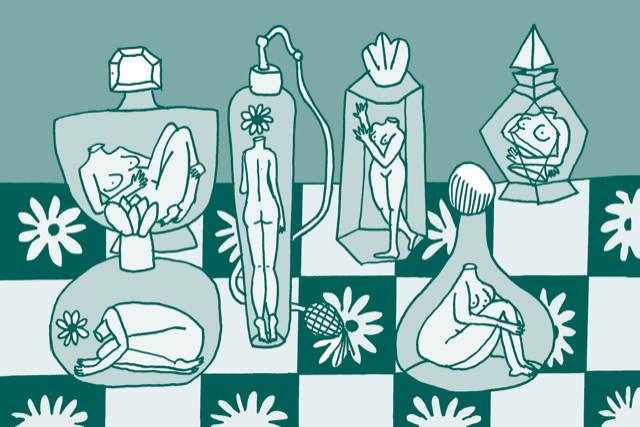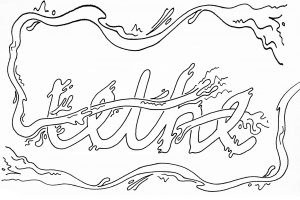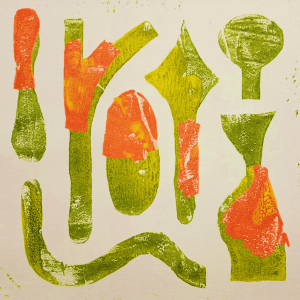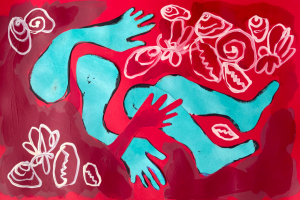
The Woman of the Perfume Ad
by By Annabel Jackson | May 26, 2019
The woman of the perfume ad is a complex construct. The advertisers who create her are geniuses of manufacturing desire, of finely chiselling models into shape with slogan and sign. Perfume ads come with tropes: her armpits are hairless; no blemish taints her skin; her hair is slicked back with seawater, or hangs in casually sophisticated waves. She is either languishing in fresh bedsheets, reclining by luxurious villas, or driving high-speed cars. She is physically liberated, emerging from pools with bursts of voluptuous energy or jumping into oceans, spurned on by a lustful joie de vivre. Yet, paradoxically, she also exists purely within a confined and constructed world of shiny surfaces; her purpose is only to be the cynosure of an airtight, imaginative play-house, one reeking of opulence and fashioned from the stuff of fantasy.
In Christian Dior’s Hellenistic-inspired ad “J’adore the New Absolu”, the music begins, and Charlize Theron strides through a pool surrounded by a legion of statuesque models. It’s the kind of atmosphere you could get drunk on: steam rises like incense in a temple, and the pool water looks glossy, honeyed, thick and golden like syrup. There is a rich evocation of the classical, not only in the pool’s visual reminiscence of the Roman baths and the toga-inspired drapery, but in the fact that the models look like classical statues – immobile, mute ideals of our perception of beauty. Their faultless skin and supple limbs lounge across steps like Dali’s dripping clocks, yet their bodies still seem to retain that stonework composure; they could be sculpted marble, or decorative effigies lining the atrium of an ancient villa. The water transforms the models’ already lithe limbs into brass-tinted, rippling reflections, and seems to relish their bare backs in its mirroring gleam. Theron then opens her eyes with gradual languor, like a dormant goddess awoken to her followers, before letting her eyelids fall back into that hooded gaze of knowing satisfaction. Pleasure – whether Sapphic, masturbatory, or pornographic – swells with the heaving strings and oozes into every moment. The music is a blend of orchestration and electronic beats that seem to seethe and promise climax. The camera zooms in or peeks around corners to bear witness to the scene like a shameless voyeur.
“J’adore the New Absolu”, then, checks off the tropes of luxury, bodily perfection, decadence, a paradoxical arrangement of liberty and enclosure, and then throws in some classically evocative motifs for good measure. It’s a pitch-perfect work of feminine perfume advertising.
But what, exactly, is this heady concoction trying to achieve? Though the ads attempt to contrive all this fleshy smothering into a narrative of female empowerment, more often than not, the ads actually reveal an internalised objectification. The seductive mood is not necessarily in place to attract men. Though the irrepressible spectre of the ‘male gaze’ hangs over perfume ads, constructing with drives and urges female beauty standards, the ads themselves are tailored towards female-imaged fantasy; they’re titillating because they expose the sexual self-representation to which we, as consumers, secretly aspire. If Theron seems gratuitously all body and no mind, it’s because a desire to appeal to men in the same way is embedded within the consumer. The ads are almost overflowing with the weight of desire – but, more than that, the desire to be desired.
Perfume ads, then, appeal to women by enacting a private fantasy in the contained and publicly sanctioned space of commerce. Opulence and lasciviousness occupy an uncomfortable space in our brains between shame and yearning; it’s rare we like to admit that they are concepts we are drawn to. Perfume ads remind us that we are in fact drawn to them, but that our feelings of shame can dissipate – can become as invisible and intangible as fragrance from a bottle. They rest upon the paradoxes and liminal spaces of desire, spaces that become essential to their aesthetic. They tap into this desire to be desired and legitimise it; they take us – invite us – over that threshold between acceptance and shameful rejection, and offer us a pastel-coloured bottle of odour at the other end.
It seems that all these tropes revolve around the fact that perfume ads are at once in love with the body and mortally afraid of it. They crave the revelation of flesh, and the overwhelming sensory daze it concocts. The ads play upon this yearning for intimacy, as the woman will often glance into the lens with half-parted lips that hover tantalisingly between speech and silence. Her mouth promises both entry and passivity – the possibility of speech, but the far greater likelihood of acquiescence. The women’s glances are captured in close-up shots that invite the viewer to insert herself into the erotic moment. You are made to feel only heartbeats away from her; you can practically feel her breath upon your cheek. In “J’adore the New Absolu”, this love for flesh borders on the cultish – the rendering of Theron as either a commander of a legion or a goddess to followers creates a mood of worship that’s mapped onto the flesh through the camera’s voyeurism. But at the same time, these ads seem unable to bear any real sense of completely unveiled, unadorned, undistracted flesh. Rather, they get off from liminality – they claw towards an exposure that never comes.
The climactic moment of “J’adore the New Absolu” isn’t the revelation of Theron’s body, as the ad seems to promise by harnessing as its central narrative her drawn-out, naked exit from that pool; rather, it is a bathetic silhouette of her body that reveals curves and shapes, but nothing nearly as tactile and specific as that which is taunted. In the next shot, she is fully clothed. It’s a strange reversal – from almost nakedness and the promise of nakedness, to concealment. It bizarrely seems to enact the opposite of foreplay, dressing Theron just at the moment the ad suggests that you should want her undressed. It confirms a fear perfume ads have of the body in its full exposure. It delays desire, to leave the viewer begging for more; not just for the full revelation of the female body, but for the scent itself, which promises to be the climactic rounding-off of all that is promised in the ad. It shows how teasing sells.
Dior’s campaign “JOY” enacts this tension. There is a semiotic obsession with cleanliness, from the crisp blue and white colour palette to Jennifer Lawrence’s almost baptismal dives into water. Yet there is a throbbing undercurrent of desire threatening to burst through like a tidal wave. But it cannot be fully consummated, partly because desire is entrenched in our minds as a private affair, and partly because the game would be up – nothing kills desire like its own fulfilment. Ads therefore depend entirely upon the perpetual postponement of climax, of the promise that is just about kept, but never quite fulfilled – of Lawrence’s silhouette, but her refrain from nudity. Instead, any real embodiment of desire persistently threatens to effervesce into the frame in full swing, a moment which would be both its release and its death. The ad suggests titillation by virtue of a surface of sanitisation, keeping the full throttle of desire at bay.
But that glance that the woman gives to the camera remains forever inviting, forever insatiate, because it is forever unconsummated. Perfume ads initiate a politics of almost – the woman is almost naked, only half-dressed in a silky nightie; she is almost seducing you, but the camera is necessarily in the way. Peter Brooks writes that the female body is ‘a desired object approached by way of an erotic dynamic of unveiling that impels the narrative forward while never quite giving access to that object’. Perfume ads work in much the same way: in “Coco Mademoiselle”, Keira Knightley literally gets unzipped out of her clothing before suddenly leaving her lover/photographer behind with a lingering, unconsummated erotic charge, and therefore an even stronger sexual longing for the absent lover. Half-unveiled, but fundamentally inaccessible, is the predicament of the woman of the perfume ad; staving off erotic fulfilment to stave off erotic death.
The effect this dynamic has on the viewer is deliberately one of titillated frustration. The point of “Coco Mademoiselle” is the undoing of our expectations of its narrative. The anticipation of sex is blatantly spattered all over the ad, from Knightley’s command to her lover to lock the door as she lies on a bed, to her voluntary decision to undress for him. The whole construction crescendos to the pulse of erotic feeling that, the viewer expects, will culminate in some frenzied heartbeat of erotic climax. But it instead follows Brook’s discussion of Freud’s notion of Vorlust, or ‘forepleasure’ – that which instigates ‘the possibility of a text that would delay, displace, and deviate terminal discharge to an extent that it became non-existent’. So the propulsive, desirous force that cultivates an anticipatory momentum and leads us toward a natural teleological end, is stifled; Knightley resists this narrative, cuts short the consummation, and begins an entirely new narrative ostensibly based off of female empowerment. There is no ‘terminal discharge’. And for that, the ad is totally erotic.
We are engaged in what Roland Barthes termed a ‘striptease’ – that performance in which the journey towards unveiling offers more pleasure than the actual unveiling itself. Brooks sees such ‘recursive moments’ that defer endings as ‘perverse’; what’s more perverse, however, is that they’re used to displace our sexual impulses onto our consumerist ones. Because the deferral of unveiling isn’t simply a cheap means of titillation – it is also the basis for the entire perfume ad. The truth they reach for is a scent we cannot smell, something that lies beyond our immediate parameters of perception; it can never be realised unless we buy the product and finally embrace the smell as the last phase of unveiling, the final lift of silk from the skin. Advertisers must displace this truth onto a figure we can see, identify with, aspire to, in order to initiate the gradual process of ‘almost-ness’ that can only be consummated by buying the product – by succumbing to the instincts of our consumerist, now, rather than erotic, desires.
This ‘almost-ness’ then becomes the kernel of the ad. There is always a gap between our imagination of a perfume and the reality of its smell, so the feeling of the scent we get from the ad will inevitably be only a rough, false sense of it. There’s no way to transmit scent through our television screens – but that’s not to say advertisers don’t try. In “Gucci Bloom”, an almost sickly abundance of plants pack a living room to create a quaint, domestic rainforest. Lake water rolls off of lilac petals. Flowers are squeezed into every shot. The result is a dreamy, earthy call to both nature and indulgence. On the one hand, it evokes Ophelia’s dying ballads; on the other, it saturates you until your mind drifts off to the smell of muddy days in spring, or the pungent vase of tulips in the hallway. It’s not quite Proust’s madeleine moment, but it certainly works in almost conveying an inaccessible redolence.
Gucci tries to collapse the gap between imagination and reality through this sensory overload. Their ads champion a material and emotional decadence by creating dreamscapes hermetically sealed-off from reality, where fast-cut images of skin, flowers, water, and moneyed surfaces are spliced together in a disorienting fantasia. But the sense they are most intent on harnessing is touch – the tactile offerings of flesh and expense. Touch is in some ways the sense in greatest alliance with smell. Even though scents themselves are pretty much immaterial, they require a material surface to persist. They require skin, bodies, to work their suggestive magic. The image that crops up most isn’t therefore flowers, as Gucci’s attempt might suggest, but water: aquamarine swimming pools, periwinkle lakes, foam-tinged oceans. Even when water itself doesn’t appear, the gleaming reflections of expensive surfaces and the dewy drip of city lights evoke that same fluidity. Water connotes liberation, and embodies the tactile demands of perfume by straddling the gap between the material and the materially evasive. It’s free to touch, but also free to slip away, and so works with the same heady fluency as smell. It cannot be grasped. It’s the very essence of perfume.
The perfume ad’s hyper-emphasis on symbolic evocation isn’t as forcefully shared by other advertisers. Ads for other luxury items also indulge in the perfume ad’s wealth porn, but take only the glamour, leaving behind the obsession with lifestyle. Handbag ads will always privilege the product over the lifestyle it represents; a Mulberry bag might spruce up a faux-Parisian outfit, but the ads certainly don’t take us down a Jungian rabbit hole of untapped fantasy. There’s no need to – Robert Greene’s assertion that ‘a fragrance doesn’t do anything’ cannot be applied to skin care or handbag brands, which perform basic but visible actions on screen, and so no overwhelming display of flowers or water are needed to get their essence across. Leather and gleaming straps are the star of the show, not the owner’s shoulder or hip. But perfume is too ephemeral and intangible to speak for itself. Other ads don’t need to flirt with soft porn; they flirt with object fetish, loving the object more than its metaphors. Even if the woman of the jewellery ad isn’t negated, she is decentred; beautiful, still, but the sideshow to the elevated product qua product.
It’s frustrating, ultimately, that perfume ads focus so intensely upon the just-out-of-reach quality of flesh, while perfume itself is used to conceal our bodies’ natural scents – to keep them in their fullness just-out-of-reach. To be so involved with our bodies, yet to refuse them in their sensory totality; to use bodies to titillate, only to then sell a product designed around their covering. In their attempts to bring us closer to scent, perfume ads have forgotten to celebrate the full reality of the body to which that scent is applied. They’re far too afraid of body hair, moles, acne, cellulite, fat rolls or any real bodily movement that might bring chaos to the sanitised order. In a way, perfume ads betray the ethos of their actual product – while perfume offers only an attempt at masking, perfume ads theorise a whole endeavour of being.
But we shouldn’t be so averse to our bodies. We shouldn’t accept Dior or Chanel’s insistence upon elegance, because it’s harmful – it encourages our female fantasies and ideals to revolve around corporeal flawlessness. We need to replace the politics of almost with the politics of the whole. That’s not to say we achieve this through the consummation of all our desires, but that we shouldn’t be afraid of the whole messy, unpleasant, and, well, smelly nature of our bodies. That’s fullness; that’s consummation. For all their exposure of skin and flesh, perfume ads only want to know the subtle lift of the enigmatic eyebrow, the breast without the nipple. Their insistence upon deferral is in part a means of keeping the flame of desire alive, of wafting it but never blowing upon it, but, more criminally, it also means the deferral of the whole female body in all its sensory glory.
We have become too lenient to the toxicity of the perfume ad, too subconsciously accepting of its subtle confirmation and creation of feminine ideals. We have become so inured to them that we see them as benign. We fail to recognise them for what they are. But perhaps times are slowly changing.
The ad for the fragrance “KENZO World”, released in 2016, depicts actress Margaret Quelley attending a prize-giving event. It uses the classic tropes of ostentatious displays of wealth, mirrors, and sheen. Until it doesn’t. Quelley gets bored, abandons the ceremony, and erupts into a spectacularly jarring dance performance, fanatically flexing and writhing as if possessed, or bitten by a venomous snake. Her rolled back eyes and frenzied, wrestled manoeuvres evoke the classical concept of the Sybil, a form of female prophet who loses all bodily control when she delivers prophecies. Virgil describes Apollo’s Sybil prophesying in the Aeneid, describing her ‘foam-frothing lips’ and claiming ‘Her colour was altered, her hair no longer in place; / But her breast heaved, with frenzy her wild heart swelled; / Taller she seemed than before’. That’s Quelley. As she leaves the dinner, she seems beyond containment, beyond being bottled. She’s a far cry from the faultlessly feminine and statuesque models of “J’adore the New Absolu”. The ad exploits the full kinetic potential of her body, as it becomes a celebration of muscularity and real, breathless vitality. Quelley still seems desirous, but seems to care much less about being desired. The narrative thrust isn’t a languorous, unconsummated unveiling – the truth of the ad lies in her body and its movements in the moment, utilised as they are to their full frenetic potential to redirect focus from an erotic, future-looking longing to a kind of non-teleological high. With rapturous glee, the ad relishes in its disruptions of the feminine.
“KENZO World” is a refreshing puncture in the semiotic order. The imaginative play-house is still there, but now the woman is rebelling against it – this time, with the whole of her body.∎




